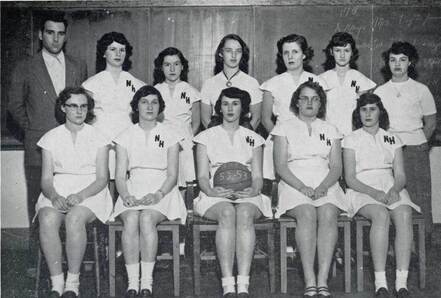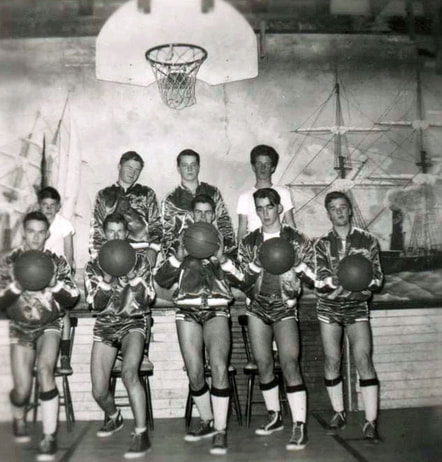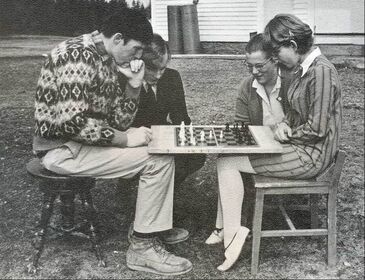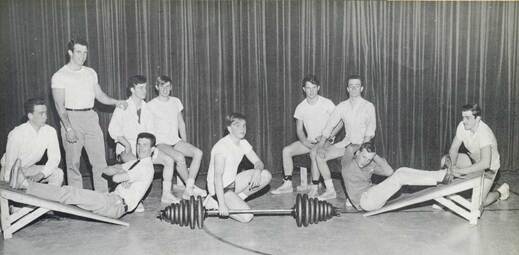ATHLETICS
After we walked one, two, or three miles to school, or had gotten up early enough to hitch a ride behind a slow horse, we really didn’t feel in need of more exercise.
Marion Brown Casperson, reflecting on attending school in the early 1900s, North Haven High School yearbook, The Pilot, 1957
Beginning in 1920, physical education was required in the elementary schools and high school on North Haven. That same year, the first basketball team formed under the instruction of high school teacher Mae Greenlaw with games played in the lower floor of nearby Union Hall, now known as the Grange Hall. Baseball teams existed in the early 1900s and a school yearbook reported a 1925 baseball team with all twelve boys in the high school, noting “we spread them around the field and succeeded in getting the places filled.”
By the 1940s, students wrote in the yearbook about the need for a gymnasium and athletic equipment:
We miss the fun that pupils of larger schools have in the use of a gymnasium. We envy those who have an opportunity to play athletic games…Of course we do have some basketball equipment now but we do not practice much. In the winter the ground is covered with snow and it is hard to be accurate on snowshoes. The rest of the school year the ground is soft and muddy and rubber boots do not enable us to move quickly. There is really little time in which we can actually enjoy out-of-door sports…The pupils do enjoy athletic exercise but because of the instability of the weather and unevenness of the ground, it is hard to participate in them to any advantage.
Grace Beverage, North Haven High School yearbook, The Pilot, 1940
In 1949, students formed an Athletic Committee and used money from yearbook sales to purchase athletic equipment, including footballs, basketballs, bats, and baseballs. On the school grounds, the high school geometry class marked off lines for a basketball court and students put up backboards. Also in 1949, a neighboring land owner, Joseph Amesbury donated land to the school for an athletic field. Student Eleanor Stone remembered:
Mr. Amesbury…gave about an acre and a half to the school for a baseball diamond. It was rough land and needed clearing. The first step was to take down the fence which separated the land from the school grounds. That was a big mistake, for there were cows in that pasture. The next morning the schoolground was full of cows. To solve this problem, the pupils put up another fence on the edge of their land…After most of the trees were cut down by the students…the town gave enough money to blast out stumps and grade off the infield of the baseball diamond. Most of the land was cleared before winter came.
North Haven High School yearbook, The Pilot, 1950
A basketball program continued during the winter of 1950 with students playing in the Grange Hall. Although the Grange was not big enough for a regulation sized court or high enough for ten foot baskets, student Eleanor Stone noted “it’s near the school and students can go play there noon times.” Elliott Brown, who was among the charter team members, remembered how players constantly bumped into the building’s center posts while playing. Bodine MacDonald was in 9th grade when the teams first formed and remembered loving any chance to play basketball. If, during a boys game, a player fouled out and no subs were available, Bodine or Eleanor “Ellie” Stone were recruited to the court.
Marion Brown Casperson, reflecting on attending school in the early 1900s, North Haven High School yearbook, The Pilot, 1957
Beginning in 1920, physical education was required in the elementary schools and high school on North Haven. That same year, the first basketball team formed under the instruction of high school teacher Mae Greenlaw with games played in the lower floor of nearby Union Hall, now known as the Grange Hall. Baseball teams existed in the early 1900s and a school yearbook reported a 1925 baseball team with all twelve boys in the high school, noting “we spread them around the field and succeeded in getting the places filled.”
By the 1940s, students wrote in the yearbook about the need for a gymnasium and athletic equipment:
We miss the fun that pupils of larger schools have in the use of a gymnasium. We envy those who have an opportunity to play athletic games…Of course we do have some basketball equipment now but we do not practice much. In the winter the ground is covered with snow and it is hard to be accurate on snowshoes. The rest of the school year the ground is soft and muddy and rubber boots do not enable us to move quickly. There is really little time in which we can actually enjoy out-of-door sports…The pupils do enjoy athletic exercise but because of the instability of the weather and unevenness of the ground, it is hard to participate in them to any advantage.
Grace Beverage, North Haven High School yearbook, The Pilot, 1940
In 1949, students formed an Athletic Committee and used money from yearbook sales to purchase athletic equipment, including footballs, basketballs, bats, and baseballs. On the school grounds, the high school geometry class marked off lines for a basketball court and students put up backboards. Also in 1949, a neighboring land owner, Joseph Amesbury donated land to the school for an athletic field. Student Eleanor Stone remembered:
Mr. Amesbury…gave about an acre and a half to the school for a baseball diamond. It was rough land and needed clearing. The first step was to take down the fence which separated the land from the school grounds. That was a big mistake, for there were cows in that pasture. The next morning the schoolground was full of cows. To solve this problem, the pupils put up another fence on the edge of their land…After most of the trees were cut down by the students…the town gave enough money to blast out stumps and grade off the infield of the baseball diamond. Most of the land was cleared before winter came.
North Haven High School yearbook, The Pilot, 1950
A basketball program continued during the winter of 1950 with students playing in the Grange Hall. Although the Grange was not big enough for a regulation sized court or high enough for ten foot baskets, student Eleanor Stone noted “it’s near the school and students can go play there noon times.” Elliott Brown, who was among the charter team members, remembered how players constantly bumped into the building’s center posts while playing. Bodine MacDonald was in 9th grade when the teams first formed and remembered loving any chance to play basketball. If, during a boys game, a player fouled out and no subs were available, Bodine or Eleanor “Ellie” Stone were recruited to the court.
Students remained hopeful for finding a bigger space to play and in 1953 gained use of Calderwood Hall, where teams and several community members prepared the space by cleaning the floor, painting the lines on, placing guards on the windows, putting up baskets, and cutting and splitting wood to heat the building.
The court at Calderwood’s Hall was so small, the foul circles and center circle overlapped. If you “ran long” upon taking a lay-up, you had to jump up on the stage on one end or run out the door, by the ticket booth, and if you couldn’t stop, go outdoors and potentially run down the front stairs…You could always tell a North Haven player because of a flat “arc” on any shot for a very good reason -- the ceilings were very low and you couldn’t shoot for any distance with a normal arc.
Floyd Calderwood, North Haven High School Class of 1962, Personal recollection on Calderwood Hall Facebook Page, 2014
Basketball, requiring a minimum of five players, was a fitting team sport for North Haven with its often small high school population. Games continue to bring the community together during the winter months to cheer on the teams, which have sometimes even qualified for and competed in state tournaments.
The court at Calderwood’s Hall was so small, the foul circles and center circle overlapped. If you “ran long” upon taking a lay-up, you had to jump up on the stage on one end or run out the door, by the ticket booth, and if you couldn’t stop, go outdoors and potentially run down the front stairs…You could always tell a North Haven player because of a flat “arc” on any shot for a very good reason -- the ceilings were very low and you couldn’t shoot for any distance with a normal arc.
Floyd Calderwood, North Haven High School Class of 1962, Personal recollection on Calderwood Hall Facebook Page, 2014
Basketball, requiring a minimum of five players, was a fitting team sport for North Haven with its often small high school population. Games continue to bring the community together during the winter months to cheer on the teams, which have sometimes even qualified for and competed in state tournaments.
While basketball has remained steady over the decades, students on North Haven have also pursued a multitude of sports -- from running to rowing, tennis to golf, volleyball to weight lifting, cheerleading to fencing. In addition, clubs formed around less physical pursuits such as cribbage, chess, robotics, and Dungeons and Dragons.
The Chess Club was organized in December under the direction of Mr. Richards. At the first meetings Richards explained the game and after considerable time and effort on the part of the members we finally learned how to move the men around. In March, a tournament was held and Peter Cooper emerged as Island Champ.
North Haven High School yearbook, The Pilot, 1966
Despite a decades long basketball rivalry between North Haven and Vinalhaven, the two islands have partnered on such sports as soccer, cross country, baseball, and softball with dedicated students commuting across the Thoroughfare in all weather to practice and compete.
The Chess Club was organized in December under the direction of Mr. Richards. At the first meetings Richards explained the game and after considerable time and effort on the part of the members we finally learned how to move the men around. In March, a tournament was held and Peter Cooper emerged as Island Champ.
North Haven High School yearbook, The Pilot, 1966
Despite a decades long basketball rivalry between North Haven and Vinalhaven, the two islands have partnered on such sports as soccer, cross country, baseball, and softball with dedicated students commuting across the Thoroughfare in all weather to practice and compete.



